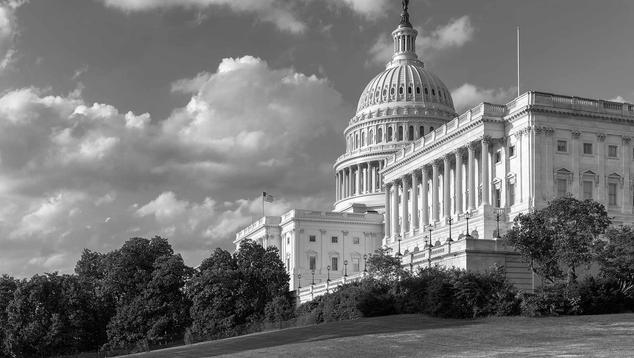Story Highlights
- Presidents below 50% approval see party lose 37 House seats, on average
- Seat loss has averaged 14 for presidents above 50% job approval
WASHINGTON, D.C. -- The president's party almost always suffers a net loss of U.S. House seats in midterm elections. However, losses tend to be much steeper when the president is unpopular. In Gallup's polling history, presidents with job approval ratings below 50% have seen their party lose 37 House seats, on average, in midterm elections. That compares with an average loss of 14 seats when presidents had approval ratings above 50%.
| Year | President/Party | % Job approval at midterm | Seat gain/loss for president's party | ||||||||||||||||||||||||||||||||||||||||||||||||||||||||||||||||||||||||||||||||||||||||||||||||
|---|---|---|---|---|---|---|---|---|---|---|---|---|---|---|---|---|---|---|---|---|---|---|---|---|---|---|---|---|---|---|---|---|---|---|---|---|---|---|---|---|---|---|---|---|---|---|---|---|---|---|---|---|---|---|---|---|---|---|---|---|---|---|---|---|---|---|---|---|---|---|---|---|---|---|---|---|---|---|---|---|---|---|---|---|---|---|---|---|---|---|---|---|---|---|---|---|---|---|---|
| 1998 | Clinton/Dem | 66 | +5 | ||||||||||||||||||||||||||||||||||||||||||||||||||||||||||||||||||||||||||||||||||||||||||||||||
| 2002 | G.W. Bush/Rep | 63 | +6 | ||||||||||||||||||||||||||||||||||||||||||||||||||||||||||||||||||||||||||||||||||||||||||||||||
| 1986 | Reagan/Rep | 63 | -5 | ||||||||||||||||||||||||||||||||||||||||||||||||||||||||||||||||||||||||||||||||||||||||||||||||
| 1962 | Kennedy/Dem | 61 | -4 | ||||||||||||||||||||||||||||||||||||||||||||||||||||||||||||||||||||||||||||||||||||||||||||||||
| 1954 | Eisenhower/Rep | 61 | -18 | ||||||||||||||||||||||||||||||||||||||||||||||||||||||||||||||||||||||||||||||||||||||||||||||||
| 1990 | G.H.W. Bush/Rep | 58 | -8 | ||||||||||||||||||||||||||||||||||||||||||||||||||||||||||||||||||||||||||||||||||||||||||||||||
| 1970 | Nixon/Rep | 58 | -12 | ||||||||||||||||||||||||||||||||||||||||||||||||||||||||||||||||||||||||||||||||||||||||||||||||
| 1958 | Eisenhower/Rep | 57 | -47 | ||||||||||||||||||||||||||||||||||||||||||||||||||||||||||||||||||||||||||||||||||||||||||||||||
| 1974 | Ford/Rep | 54 | -43 | ||||||||||||||||||||||||||||||||||||||||||||||||||||||||||||||||||||||||||||||||||||||||||||||||
| 1978 | Carter/Dem | 49 | -11 | ||||||||||||||||||||||||||||||||||||||||||||||||||||||||||||||||||||||||||||||||||||||||||||||||
| 1994 | Clinton/Dem | 46 | -53 | ||||||||||||||||||||||||||||||||||||||||||||||||||||||||||||||||||||||||||||||||||||||||||||||||
| 2010 | Obama/Dem | 45 | -63 | ||||||||||||||||||||||||||||||||||||||||||||||||||||||||||||||||||||||||||||||||||||||||||||||||
| 2014 | Obama/Dem | 44 | -13 | ||||||||||||||||||||||||||||||||||||||||||||||||||||||||||||||||||||||||||||||||||||||||||||||||
| 1966 | Johnson/Dem | 44 | -47 | ||||||||||||||||||||||||||||||||||||||||||||||||||||||||||||||||||||||||||||||||||||||||||||||||
| 1982 | Reagan/Rep | 42 | -28 | ||||||||||||||||||||||||||||||||||||||||||||||||||||||||||||||||||||||||||||||||||||||||||||||||
| 1950 | Truman/Dem | 39 | -29 | ||||||||||||||||||||||||||||||||||||||||||||||||||||||||||||||||||||||||||||||||||||||||||||||||
| 2006 | G.W. Bush/Rep | 38 | -30 | ||||||||||||||||||||||||||||||||||||||||||||||||||||||||||||||||||||||||||||||||||||||||||||||||
| 1946 | Truman/Dem | 33 | -55 | ||||||||||||||||||||||||||||||||||||||||||||||||||||||||||||||||||||||||||||||||||||||||||||||||
| Note: Ford took office in August 1974, about three months before the midterm elections, after Nixon resigned. Nixon had a 24% job approval rating when he resigned. | |||||||||||||||||||||||||||||||||||||||||||||||||||||||||||||||||||||||||||||||||||||||||||||||||||
| Gallup | |||||||||||||||||||||||||||||||||||||||||||||||||||||||||||||||||||||||||||||||||||||||||||||||||||
History, then, is not on the Republicans' side this fall, as President Donald Trump has a 40% job approval rating two months before the 2018 midterm elections. With Republicans holding the White House and the majority of both houses of Congress, the lines of accountability are clear for voters who are unhappy with the state of the nation. Democrats need a net gain of 23 seats to take majority control of the House of Representatives.
For all midterm elections since 1946, the average midterm loss for the president's party is 25 U.S. House seats. Only two presidents, Bill Clinton and George W. Bush, saw their party gain seats in a midterm election. Both Clinton (66%) and Bush (63%) had high approval ratings just before those elections. Still, that popularity provided only enough boost to help their party pick up a handful of seats -- five for Clinton in 1998 and six for Bush in 2002.
Majority-approval presidents have not always been immune from the political forces that typically create big changes in power at midterm elections. Dwight Eisenhower's GOP lost 47 seats in 1958 when he had a 57% job approval rating, although that was one of his lowest ratings as president and occurred as an economic recession was ending. Republican House members elected in 1956 on Eisenhower's coattails also lacked his presence at the top of the ballot in 1958.
Additionally, Gerald Ford and the Republican Party lost 43 seats in 1974 when 54% approved of Ford. Ford was still in the honeymoon phase of his presidency, having been in office about three months when the elections took place. The strong Democratic showing likely was more of a reflection on former President Richard Nixon, who resigned office amid the Watergate scandal in August 1974 (at which time he had a 24% approval rating) and a poor economy.
Among presidents with approval ratings below 50%, Jimmy Carter had the smallest seat loss of 11 in 1978 when his approval rating was 49%. Barack Obama and the Democrats lost just 13 seats in 2014, but that was four years after they lost a post-World War II high of 63 seats in 2010.
Seat loss is affected by how many seats the president's party holds going into the election. Democrats held 255 seats before the 2010 election -- among their highest since the early 1990s -- but only 201 in 2014 when they were the minority party. Republicans enter the 2018 midterms with 236 seats, a high total for them, not counting four additional seats that are vacant but were last held by Republicans.
Overall, the basic relationship between presidential job approval and midterm U.S. House seat loss is strong, with a statistical correlation of .66. A correlation of 0 indicates no relationship between two variables, and a correlation of 1 represents a perfect linear relationship.
Implications
The political environment in this year's midterm elections favors the Democratic Party, with Trump's approval rating stuck in the low 40s as voters head to the polls in about two months.
Recent history provides even more ominous signs for the GOP. Like Trump, each of the prior three presidents took office having majorities in both houses of Congress. However, Obama, Clinton and Bush left office with the opposition in control.
Special elections for open congressional seats the past two years also suggest a difficult year for the GOP, with Republicans narrowly winning and, in some cases, losing seats that the party usually wins by comfortable margins.
GOP hopes for maintaining their majority status in Congress may rest mostly on the political map, and whether districts that favor Republican candidates are favorable enough that their party can win even if the district votes much more Democratic than usual.




